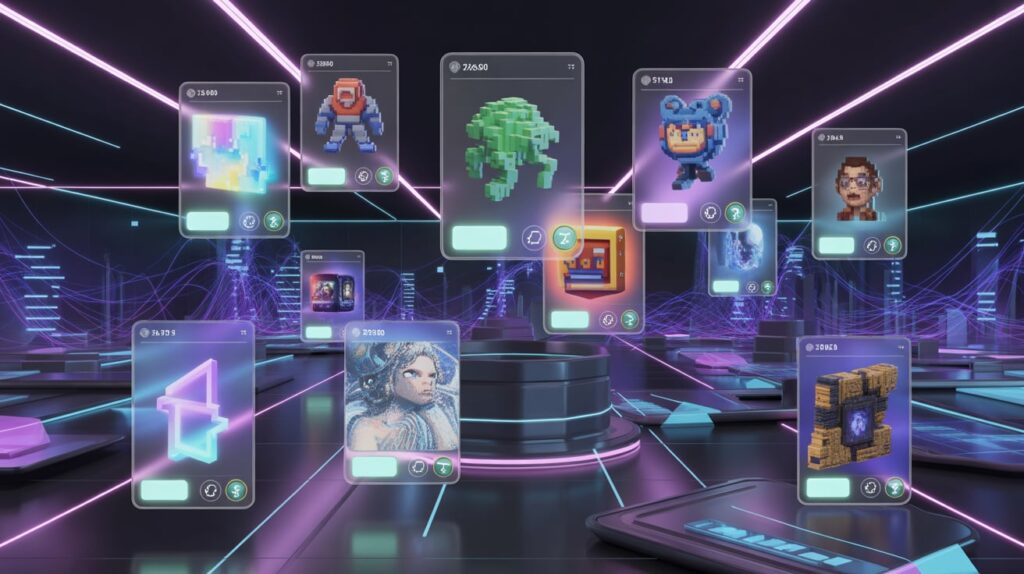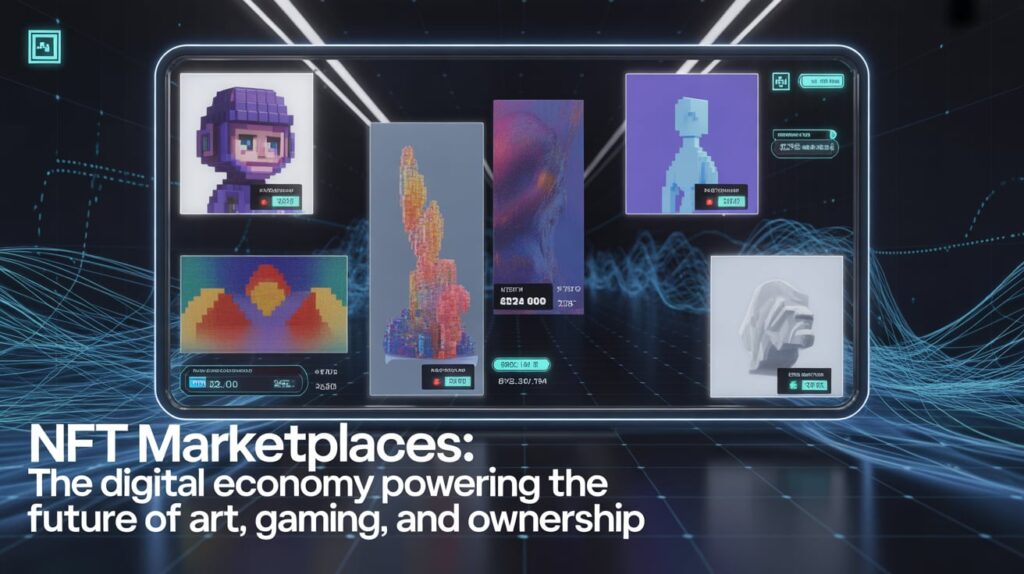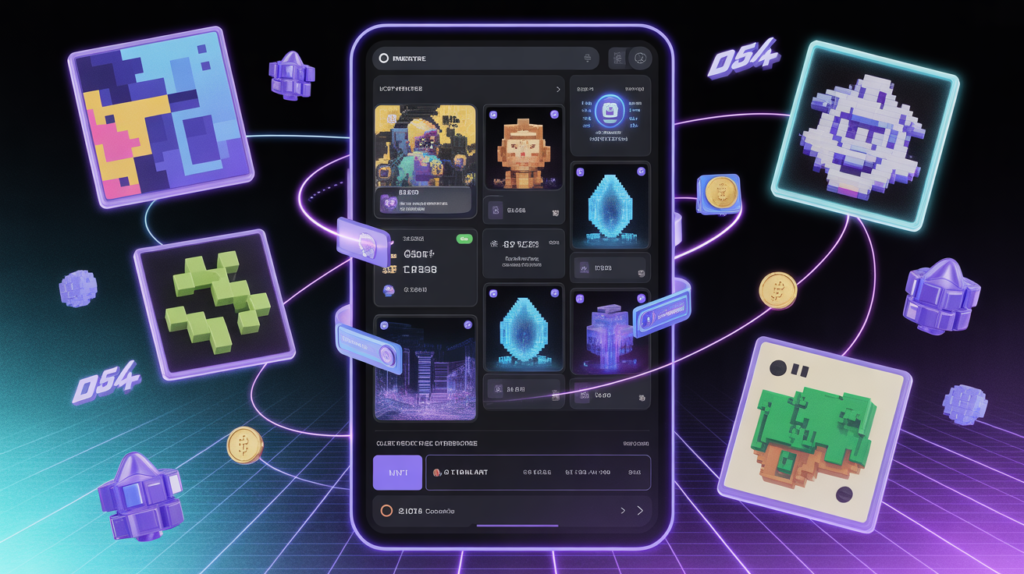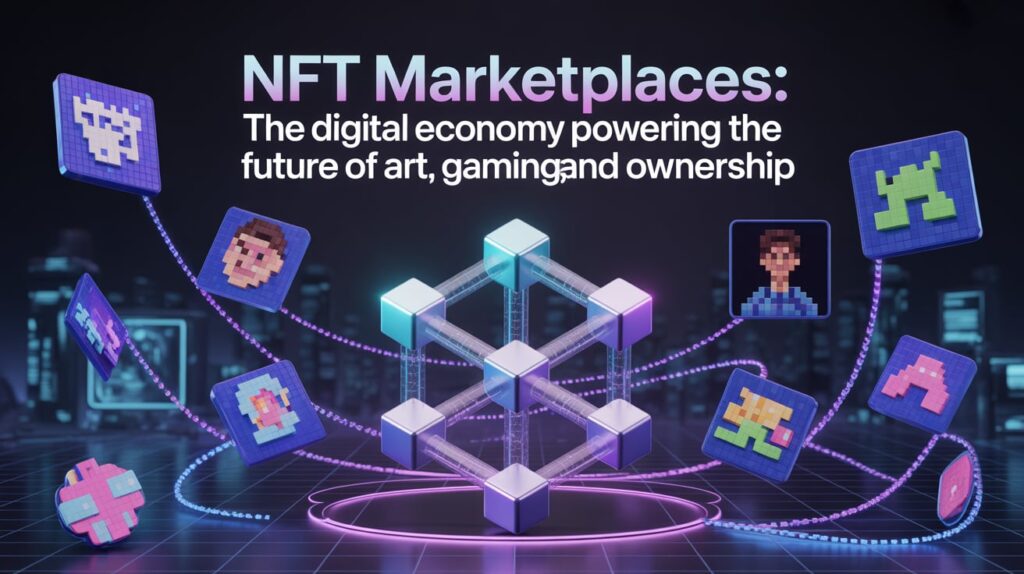NFT Marketplaces: The Digital Economy Powering the Future of Art, Gaming, and Ownership
The rise of NFT marketplaces has transformed how we perceive value, creativity, and ownership in the digital age. What began as a niche trend among crypto enthusiasts has now evolved into a global ecosystem bridging artists, investors, and collectors.
According to BTCMARKETNEWS, the NFT industry surpassed $50 billion in trading volume in 2024, and by 2025, NFT marketplaces continue to reshape art, gaming, real estate, and even identity verification. These platforms have become the backbone of a new creator economy—decentralized, transparent, and borderless.
1. What Are NFT Marketplaces?
NFT marketplaces are online platforms where users can mint, buy, sell, and trade non-fungible tokens (NFTs). Each NFT represents a unique digital asset—an image, video, song, document, or even a virtual piece of land—verified and secured through blockchain technology.
Unlike fungible cryptocurrencies like Bitcoin or Ethereum, every NFT carries distinct metadata and ownership proof. Popular NFT marketplaces such as OpenSea, Blur, Rarible, and Magic Eden act as decentralized exchanges for digital collectibles and assets.
BTCMARKETNEWS explains that these marketplaces enable creators to monetize their work directly, without intermediaries like galleries or streaming services.
2. How NFT Marketplaces Work
Every transaction on NFT marketplaces happens through blockchain smart contracts. Here’s a simplified breakdown:
-
Minting — Creators “mint” digital files into NFTs by uploading them and linking ownership metadata to a blockchain address.
-
Listing — The NFT is listed for sale, either at a fixed price or through an auction.
-
Buying/Selling — Buyers connect crypto wallets (like MetaMask) to make purchases in tokens such as ETH, SOL, or MATIC.
-
Royalties — Smart contracts allow creators to earn a percentage (usually 5 – 10 %) from every future resale.
These programmable royalties make NFT marketplaces revolutionary for artists and developers seeking long-term, passive income.
3. Types of NFT Marketplaces
According to BTCMARKETNEWS, NFT marketplaces can be classified into several categories based on their use cases and blockchain networks:
a. General Marketplaces
Platforms like OpenSea, LooksRare, and X2Y2 support a wide variety of assets—art, music, collectibles, and virtual worlds.
b. Art-Focused Marketplaces
Curated platforms such as SuperRare, Foundation, and Nifty Gateway emphasize quality and exclusivity for professional digital artists.
c. Gaming & Metaverse Marketplaces
Projects like Axie Infinity, Decentraland, and Sandbox feature NFTs as in-game assets or virtual land plots that players can own, trade, or lease.
d. Blockchain-Specific Marketplaces
Marketplaces like Objkt (Tezos), Magic Eden (Solana), and Zora (Ethereum L2) focus on specific blockchain ecosystems, optimizing gas fees and transaction speeds.
4. Trends Defining NFT Marketplaces in 2025
BTCMARKETNEWS identifies several emerging trends shaping the evolution of NFT marketplaces:
1. Multi-Chain Expansion
Marketplaces are integrating cross-chain bridges so users can trade NFTs across multiple blockchains. This interoperability improves liquidity and accessibility.
2. AI-Generated NFTs
AI tools now assist in creating unique artworks and verifying originality. Many NFT marketplaces use AI for fraud detection and plagiarism prevention.
3. Fractionalized NFTs
High-value NFTs can be split into smaller ownership shares, allowing multiple investors to co-own premium digital assets.
4. Real-World Asset (RWA) Integration
NFTs are expanding beyond art—tokenizing real estate, luxury goods, and intellectual property. This bridges DeFi and real-world ownership.
5. Eco-Friendly Minting
To combat environmental concerns, platforms are adopting proof-of-stake (PoS) blockchains like Polygon and Tezos, significantly reducing carbon footprints.
5. Benefits of Using NFT Marketplaces
-
True Ownership: Blockchain technology ensures transparent and immutable ownership records.
-
Creator Empowerment: Artists can directly monetize their work without intermediaries.
-
Global Accessibility: Anyone with a wallet can participate—no banks or borders.
-
Programmable Royalties: Automated payments provide recurring revenue streams.
-
Community Governance: Many platforms are DAO-based, allowing users to vote on policies and upgrades.
As BTCMARKETNEWS notes, these advantages make NFT marketplaces a cornerstone of the digital-asset revolution.
6. Challenges Facing NFT Marketplaces
Despite explosive growth, NFT marketplaces still face obstacles:
-
Market Volatility: NFT prices fluctuate with crypto markets, discouraging long-term investors.
-
Scams and Fraud: Fake listings and plagiarized art remain widespread.
-
Regulatory Uncertainty: Governments are developing frameworks to classify NFTs for taxation and copyright purposes.
-
Liquidity Issues: Many NFTs remain illiquid due to low secondary-market demand.
-
User Experience: Onboarding new users still requires crypto literacy and wallet setup.
BTCMARKETNEWS emphasizes that security audits, transparency, and user education will be key to overcoming these issues.
7. How NFT Marketplaces Earn Revenue
Marketplaces generate income through:
-
Transaction Fees: Typically 2 – 5 % of each sale.
-
Listing Fees: Some platforms charge creators for minting.
-
Premium Services: Curation, analytics dashboards, and marketing exposure.
-
Token Incentives: Platforms like Blur reward traders with governance tokens.
These revenue streams sustain ecosystem growth while encouraging fair competition and innovation.
8. Regulation and Compliance in NFT Marketplaces
As trading volumes grow, regulators are paying close attention. The U.S. SEC, EU MiCA framework, and Asian regulators are assessing NFTs for compliance with securities and intellectual-property laws.
BTCMARKETNEWS reports that leading NFT marketplaces are adopting KYC verification, anti-money-laundering (AML) protocols, and royalty-tracking systems to stay compliant while maintaining decentralization.
9. Future of NFT Marketplaces
Looking toward 2026 and beyond, BTCMARKETNEWS forecasts several developments:
-
Integration with DeFi: NFTs will become collateral for loans and yield-generation products.
-
Dynamic NFTs (dNFTs): Assets that evolve over time—used in games, sports collectibles, and tokenized identities.
-
Metaverse Expansion: Virtual land ownership and avatar customization will drive mainstream adoption.
-
Enterprise Adoption: Brands like Nike, Adidas, and Warner Bros. will continue launching branded NFTs through white-label marketplaces.
-
Education and Security: Platforms will invest in tutorials and blockchain authentication to protect new users.
By 2030, NFT marketplaces are expected to underpin not just art and gaming but also finance, supply chains, and government records.
10. How to Get Started with NFT Marketplaces
-
Create a Wallet: Use MetaMask, Trust Wallet, or Phantom to connect to marketplaces.
-
Buy Crypto: Purchase ETH, SOL, or MATIC from trusted exchanges.
-
Choose a Marketplace: Select based on fees, blockchain, and audience.
-
Mint or Buy NFTs: Upload your creation or explore listings for purchase.
-
Secure Your Assets: Store NFTs in hardware wallets or multi-signature vaults.
As BTCMARKETNEWS advises, always verify contracts and avoid unsolicited links or offers.
Conclusion
NFT marketplaces have moved far beyond speculative hype—they now define a new era of digital ownership. Whether you’re an artist, gamer, investor, or brand, these decentralized platforms offer opportunities to engage with creativity, technology, and finance in entirely new ways.
With innovations like cross-chain interoperability, AI-assisted curation, and regulatory evolution, the next generation of NFT marketplaces will empower millions of users to truly own their digital worlds.
As BTCMARKETNEWS concludes: “NFT marketplaces are not just changing art—they’re redefining the internet economy itself.”
FAQs – NFT Marketplaces
1. What are NFT marketplaces?
They are blockchain-based platforms where users can mint, buy, sell, and trade digital assets like art, music, or in-game items.
2. Which are the best NFT marketplaces in 2025?
Top platforms include OpenSea, Blur, Magic Eden, Rarible, and SuperRare, depending on your use case.
3. Are NFT marketplaces safe?
Yes, if you use verified, audited platforms and protect your wallet with strong security practices.
4. Can I make money with NFTs?
Yes—by creating, collecting, or flipping NFTs, or earning royalties on future sales.
5. Why follow BTCMARKETNEWS for NFT insights?
Because BTCMARKETNEWS delivers accurate, expert-verified updates on blockchain trends, market data, and digital-asset innovation.



